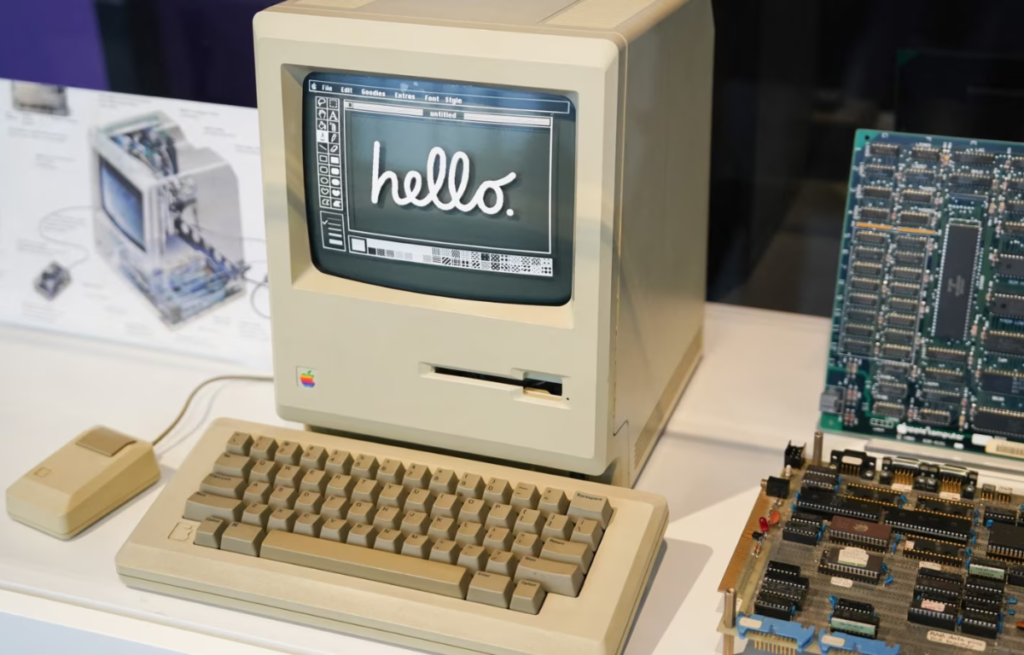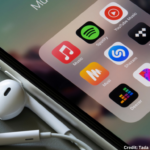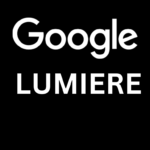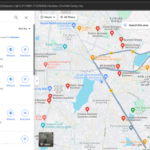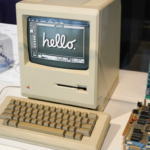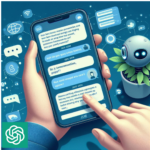Unveiling Apple Macintosh: A Unique Debut Remembered from the 1984 Super Bowl Commercial
In 1984, during the iconic American football Super Bowl game, Apple introduced the Macintosh computer to the world through a groundbreaking television commercial. Contrary to expectations, the ad did not showcase the computer itself. Instead, it featured a woman throwing a hammer at a large screen displaying a speech by a man. As the screen exploded, an announcer proclaimed, ‘Apple Computer will introduce Macintosh… And you’ll see why 1984 won’t be like ‘1984.’
This bold move drew inspiration from George Orwell’s dystopian novel ‘1984,’ highlighting Apple’s commitment to offering a computing experience that defied the norms of authoritarian control. The underlying message conveyed that the new Macintosh would be revolutionary and remarkably user-friendly, setting it apart from the technological landscape of its time.
Apple’s Made with humans in mind
During an era when computers were limited to performing just a few tasks, users grappled with the complexities of typing intricate commands to initiate programs.
Jacob O. Wobbrock, a distinguished professor of information at the University of Washington, shared his insights on Apple’s paradigm-shifting commercial in The Conversation. He emphasized that Apple, through this commercial, positioned itself as a purveyor of products designed for human use. This marked a turning point, thrusting Apple into the spotlight for its commitment to design, laying the foundation for the burgeoning concept of user experience (UX) or human-computer interaction.
Wobbrock highlighted, “The Macintosh was one of the first products to really prioritize user experience and focus on making something usable, understandable, learnable, even guessable. So that people didn’t have to always read a manual to learn how to use it.”
Mackenzie Bristow, a former language teacher turned user experience professional in Atlanta, Georgia, echoed this sentiment. She asserted that the Macintosh was a trailblazer in considering “the user” in product design. Bristow emphasized the importance of understanding the user’s role before delving into product aesthetics and functionality.
Now, four decades since the Macintosh’s debut, computer screens permeate our surroundings – from restaurants and airports to cars. Each of these devices reflects the legacy of user experience expertise, with professionals dedicated to crafting interfaces that seamlessly integrate with human interaction.
Apple’s STEM plus ‘soft skills’
Unlocking User Experience Education: Diverse Paths and Inclusive Perspectives
In the dynamic landscape of higher education, numerous colleges and universities have embraced the growing demand for user experience (UX) study programs. While traditionally associated with STEM (science, technology, engineering, and math), UX has evolved into a multidisciplinary field, welcoming students from diverse backgrounds such as psychology or communication.
According to Jacob O. Wobbrock, a professor of information at the University of Washington, the key to thriving in UX lies in a genuine curiosity about how people interact with technology. He emphasizes that students, regardless of their primary area of study, can find success in the field. Wobbrock further notes that proficiency in English is not a barrier, affirming that students with English as a second language can excel in UX.
Kartik Sundaram, a graduate of the University of Michigan, attests to this diversity. Originally a computer science student, Sundaram transitioned to UX for his graduate studies after discovering its blend of design, human interaction, and technology. Sundaram emphasizes the importance of “soft skills,” including personability and relationship-building, in the UX realm.
For Sundaram, and others like him, UX offers an engaging alternative to more isolating fields. He encourages prospective students to explore this dynamic discipline, highlighting the significance of being adaptable and making connections.
Interestingly, Sundaram believes that proficiency in multiple languages is a valuable asset in UX, describing it as a “superpower.” Mackenzie Bristow, a former language teacher now working in UX in Atlanta, echoes this sentiment, celebrating the diversity of language skills in UX professionals. She emphasizes the inclusive nature of the field, where effective communication and a global perspective are highly valued, regardless of language fluency or accent.
In the ever-expanding realm of UX education, these narratives underscore the field’s inclusive ethos and the diverse journeys individuals embark on to contribute to the evolving landscape of user experience.
Navigating the Intersection of UX and AI: Insights from Industry Professionals
In the ever-evolving landscape of technology, professionals like Kartik Sundaram, Jacob O. Wobbrock, and Mackenzie Bristow are at the forefront, shaping the future of user experience (UX) and its integration with artificial intelligence (AI).
Sundaram, a recent graduate teaching UX, is actively seeking opportunities in the field. He envisions a future where interactions with AI extend beyond traditional text boxes in platforms like ChatGPT. According to him, the evolving nature of technology will introduce novel ways to engage with AI.
Bristow, contributing to training programs at a prominent company, emphasizes the pivotal role of language understanding in AI. As AI becomes more sophisticated, experts are needed to interpret how language varies based on factors such as geographic location, educational background, and age.
Wobbrock, a seasoned professor, sheds light on the emerging field of human-AI interaction. He underscores the growing demand for UX professionals to navigate the intricacies of how people and AI can collaborate profitably. The fusion of human experience and artificial intelligence is presenting exciting challenges and opportunities for those in the UX domain.
However, Sundaram issues a cautionary note about the popularity of UX study programs. He acknowledges the rising trend of students viewing UX as a lucrative field with minimal certification requirements. Despite the competitive job market and some companies downsizing experienced professionals, Sundaram remains optimistic. He sees UX as an incredible field with ongoing developments, especially with the emergence of new interfaces that demand the expertise of UX professionals.
As the field of UX converges with the expanding realm of AI, these insights from industry professionals shed light on the dynamic landscape and the critical role that UX experts play in shaping the future of human-AI interaction.
This is Dan Friedell, and I’m Jill Robbins, bringing you the latest perspectives on the intersection of UX and AI.
ALSO READ: ChatGPT : The Future Of AI Chatting On Android With Just One Button

